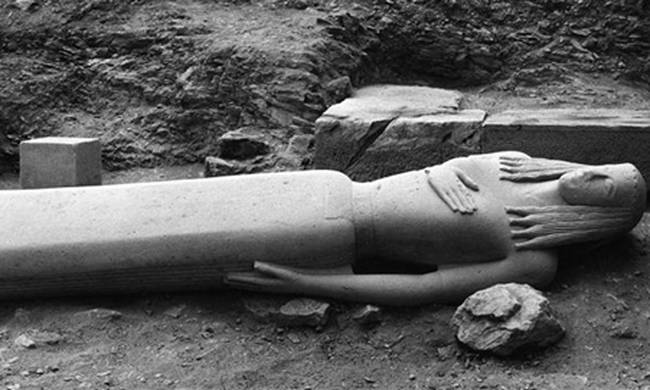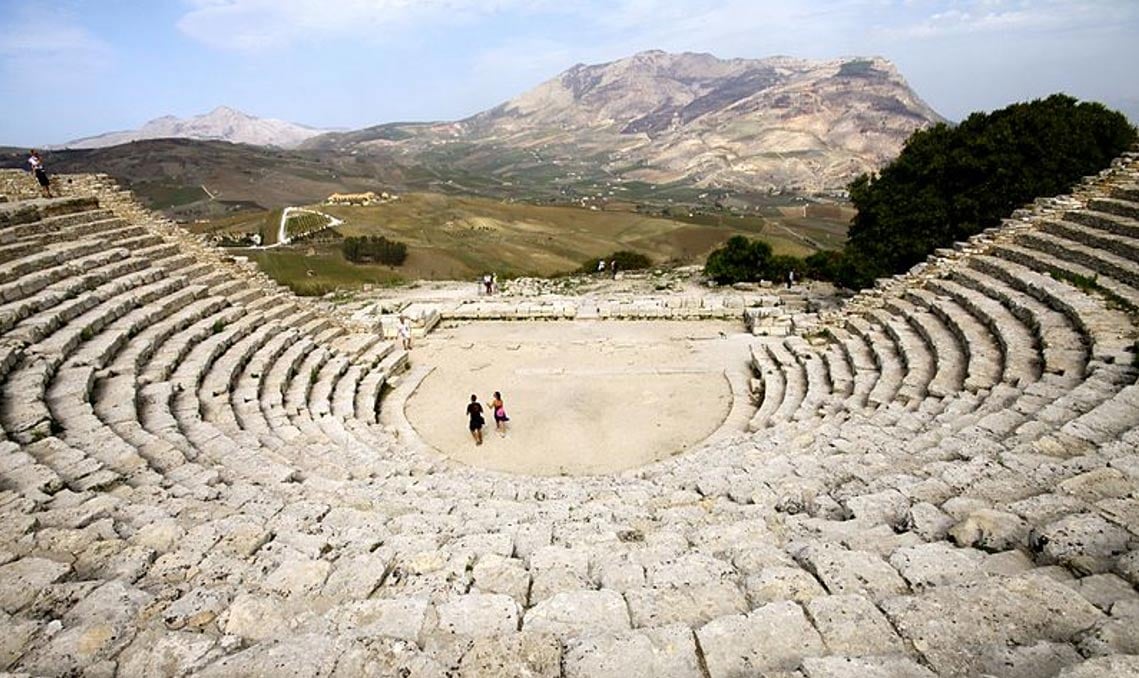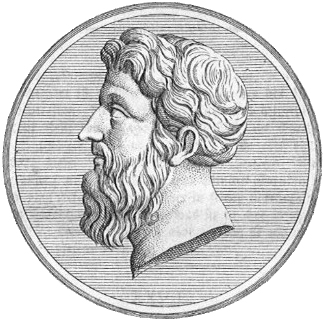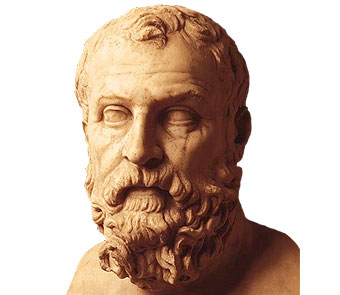Let's do another news round-up, shall we, as much has happened in and concerning Greece--and no, I am nto talking about the current economic situation, which is of course horrible. Today on the agenda: signs of second shipwreck found at Antikythera, the Kore of Thera will be on display as of next year, and the Acropolis Museum celebrates its sixth anniversary with antiquities from Samothrace.
Signs of second shipwreck found at Antikythera
The Archaeology News Network reports that the Ephorate of Underwater Antiquities, in collaboration with the American Woods Hole Oceanographic Institution, has completed the digital underwater surveying and dimensional precision display of the Shipwreck of Antikythera.
Last year’s imprinting pinpointed the exact shipwreck site of the vessel that carried the Antikythera Mechanism. However, the proximity of other findings such as anchors and amphorae from the same era made archaeologists consider the possibility that there was a second cargo vessel that accompanied the original ship. Therefore it became imperative to map a wider area of 350X45 meters approximately.
Archaeologists now can put all the findings together and draw conclusions about the possible relationship between the two wreck positions. The detailed mapping creates a clearer picture of the relationship between the two sites, while the placement of the findings in the now imprinted area enhances the understanding of all the findings in the two positions.
Resources for the investigation/excavation were provided by the Woods Hole Oceanographic Institute, American, European and Greek organizations, to meet the needs in qualified technical and scientific personnel. The Catherine Laskaridis Foundation contributed greatly by offering the vessel that was used as the basis of the research team.
The Ephorate of Underwater Activities and its partners will continue research at the end of the summer season. The Antikythera shipwreck research is conducted on a five-year plan. The mapping was done by a specialized team of the University of Sydney using the autonomous underwater vehicle Sirius.
Kore of Thera will be on display as of next year
A 2.3-meter-high archaic-era statue dubbed the 'Kore of Thera', which was found during excavations on Santorini 15 ago will be exhibited on the renowned holiday island’s archaeological museum next year, the culture ministry announced. Additionally, an agreement between the ministry and the island’s municipal government will fund excavation in the area of Medieval Kastelia. Thera is the ancient name of the island.
Acropolis Museum celebrates its sixth anniversary with antiquities from Samothrace
The Acropolis Museum is celebrating its sixth anniversary on June 20 with the inauguration of the temporary exhibition 'Samothrace. The mysteries of the great gods'. The exhibition, a cooperation of the Acropolis Museum and the Antiquity Ephorates of the prefectures of Rodopi and Evros and the expert of Samothrace antiquities Dimitris Matsas, will open for the public on June 20 and will run until September 30. The museum’s Board of Directors President, Dimitris Pandermalis, stressed in a Press Conference about the exhibition that:
The relationship between the ancient Hellenes and their Gods was well known and existed publicly in daily life. However, from very early times, mystery cults began to emerge that were accessible only to those who had been accepted into the rites following certain trials. The most famous ‘Mysteries’ in antiquity were those of Eleusis and Samothrace. The strict prohibition against insiders ever divulging the contents of the sacraments has not allowed much information to be gleaned about the ancient mysteries. Archaeological excavations in the Sanctuary at Samothrace, however, have brought to light buildings and paraphernalia belonging to the cult that allow us to form an impression of events.
As an introduction to the Mysteries of Samothrace, an assortment of finds has been selected from the site of Mikro Vouni, located a few kilometers southwest of the sanctuary, where excavations have revealed a settlement with an organized social structure of the 2nd millennium BC. Of particular importance are the Minoan stamp seals and seal impressions with representations of a double ax and fish, which have counterparts at Knossos. Perhaps the ancient tradition that gave rise to the Mysteries originated in prehistoric Crete and from there spread to other places, where it became the basis for subsequent historical developments.
The arrangement of the exhibition within the gallery is inspired by two circular constructions in the sanctuary. The first is the Theatral Circle with tiers for standing spectators, an altar in the center and pedestals around the periphery for statues from which survive many examples of bronze eyelashes. In this place was also discovered the golden lion of Persian origin, which once adorned a garment or object. For the content of the exhibition, please visit this article on The Archaeological News Network.
Signs of second shipwreck found at Antikythera
The Archaeology News Network reports that the Ephorate of Underwater Antiquities, in collaboration with the American Woods Hole Oceanographic Institution, has completed the digital underwater surveying and dimensional precision display of the Shipwreck of Antikythera.
Last year’s imprinting pinpointed the exact shipwreck site of the vessel that carried the Antikythera Mechanism. However, the proximity of other findings such as anchors and amphorae from the same era made archaeologists consider the possibility that there was a second cargo vessel that accompanied the original ship. Therefore it became imperative to map a wider area of 350X45 meters approximately.
Archaeologists now can put all the findings together and draw conclusions about the possible relationship between the two wreck positions. The detailed mapping creates a clearer picture of the relationship between the two sites, while the placement of the findings in the now imprinted area enhances the understanding of all the findings in the two positions.
Resources for the investigation/excavation were provided by the Woods Hole Oceanographic Institute, American, European and Greek organizations, to meet the needs in qualified technical and scientific personnel. The Catherine Laskaridis Foundation contributed greatly by offering the vessel that was used as the basis of the research team.
The Ephorate of Underwater Activities and its partners will continue research at the end of the summer season. The Antikythera shipwreck research is conducted on a five-year plan. The mapping was done by a specialized team of the University of Sydney using the autonomous underwater vehicle Sirius.
Kore of Thera will be on display as of next year
A 2.3-meter-high archaic-era statue dubbed the 'Kore of Thera', which was found during excavations on Santorini 15 ago will be exhibited on the renowned holiday island’s archaeological museum next year, the culture ministry announced. Additionally, an agreement between the ministry and the island’s municipal government will fund excavation in the area of Medieval Kastelia. Thera is the ancient name of the island.
Acropolis Museum celebrates its sixth anniversary with antiquities from Samothrace
The Acropolis Museum is celebrating its sixth anniversary on June 20 with the inauguration of the temporary exhibition 'Samothrace. The mysteries of the great gods'. The exhibition, a cooperation of the Acropolis Museum and the Antiquity Ephorates of the prefectures of Rodopi and Evros and the expert of Samothrace antiquities Dimitris Matsas, will open for the public on June 20 and will run until September 30. The museum’s Board of Directors President, Dimitris Pandermalis, stressed in a Press Conference about the exhibition that:
“In our country we have the advantage that most of the exhibitions presented in museums can be related to archaeological sites and excavations. Moreover, the history of the discovery and preservation of antiquities enriches our knowledge and allow for a better interpretation of the exhibits”
The relationship between the ancient Hellenes and their Gods was well known and existed publicly in daily life. However, from very early times, mystery cults began to emerge that were accessible only to those who had been accepted into the rites following certain trials. The most famous ‘Mysteries’ in antiquity were those of Eleusis and Samothrace. The strict prohibition against insiders ever divulging the contents of the sacraments has not allowed much information to be gleaned about the ancient mysteries. Archaeological excavations in the Sanctuary at Samothrace, however, have brought to light buildings and paraphernalia belonging to the cult that allow us to form an impression of events.
“Insiders believed that by invoking the Great Gods they would be saved from any serious dangers at sea and, as members of the Mysteries, they would become more just and pious people. The rituals were held at night, the Sanctuary illuminated with torches, during which initiates had to participate in a purification ceremony, to confess their greatest sins, to attend the sacred narrative speech that included mythological stories, to wear the wide, purple sash around their waists and to witness the unveiling of sacred symbols."
As an introduction to the Mysteries of Samothrace, an assortment of finds has been selected from the site of Mikro Vouni, located a few kilometers southwest of the sanctuary, where excavations have revealed a settlement with an organized social structure of the 2nd millennium BC. Of particular importance are the Minoan stamp seals and seal impressions with representations of a double ax and fish, which have counterparts at Knossos. Perhaps the ancient tradition that gave rise to the Mysteries originated in prehistoric Crete and from there spread to other places, where it became the basis for subsequent historical developments.
The arrangement of the exhibition within the gallery is inspired by two circular constructions in the sanctuary. The first is the Theatral Circle with tiers for standing spectators, an altar in the center and pedestals around the periphery for statues from which survive many examples of bronze eyelashes. In this place was also discovered the golden lion of Persian origin, which once adorned a garment or object. For the content of the exhibition, please visit this article on The Archaeological News Network.
-
Tuesday, June 30, 2015
ancient Hellenic culture archeology Athens current affairs modern Greece Persephone Samothrace





















